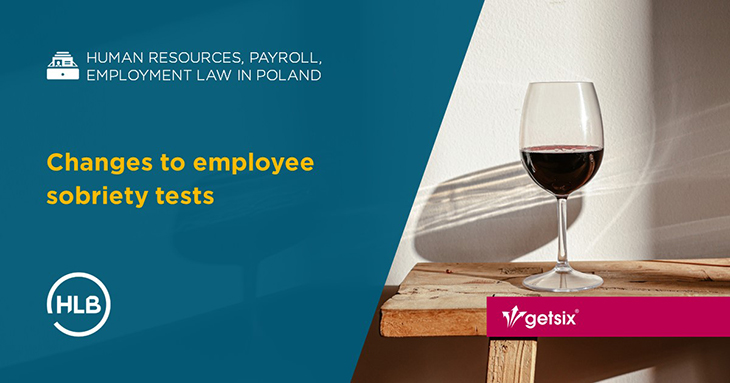Changes to employee sobriety tests

We present the most important legal changes regarding employee sobriety checks.
Possibility to introduce employee sobriety checks
An employer may introduce sobriety checks for employees if it is necessary to ensure:
- the protection of the life and health of employees or other persons,
- the protection of property.
Sobriety testing
An employee sobriety test determines the absence of alcohol in the employee’s organism or the presence of alcohol indicating a state of drunkenness or intoxication.
Cases in which the alcohol content does not reach or does not lead to meeting the values appropriate for a state after the use of alcohol (from 0.1 to 0.25 mg in 1 dm3 of exhaled air) shall be deemed to be equivalent to the determination of the absence of alcohol (a result of 0.0) in the employee’s organism.
How to carry out a sobriety test
It should be noted that the sobriety test shall not violate the dignity and other personal rights of the employee.
A situation in which an employee could perceive a sobriety test as a form of mobbing should be avoided (e.g., one of the employees is tested much more often than the co-workers, even though the previous test did not show any alcohol). The employer’s sobriety check may involve tests that do not require laboratory methods. Therefore, it is not acceptable to take a blood sample for a sobriety test on the employer’s instructions. The test shall be carried out with a device that has a valid document confirming its calibration. Before carrying out the test, it is necessary to ensure that the device (breathalyser) at the employer’s disposal has valid documentation. Disposable mouthpieces must be used when taking the measurements, and the mouthpiece packaging must be opened in the presence of the tested employee.
At the request of the tested employee, a test result of more than 0.00 mg/dm3 must be verified by taking a second measurement. If the first test result shows an alcohol-impaired state and the second test result shows a sober state, then it should be confirmed by a third test.
Test results
The employer shall store the information about when the test took place and the result indicating a state of alcohol use or a condition of intoxication in the personnel file for up to one year from its collection.
However, if:
- an administrative penalty has been imposed – the information is kept until the penalty is declared null and void,
- the information may constitute or constitute evidence in a proceeding, and when the employer is a party to that proceeding or has become aware of its initiation – the test information is kept until the proceeding has become final.
If the sobriety test indicates a presence of alcohol in the employee’s body (from 0.1 mg of alcohol per 1 dm3 in exhaled air or 0.2 per mille in the blood), the employer does not admit him to work.
In such a situation, at the request of the employer or the non-admitted employee, a test is carried out by an authorised authority (e.g., the police). Usually, the authority carries out a test that does not require laboratory tests, but the legislator also specifies situations where the authorised authority may order a blood test. If such a test shows that the employee was sober, the employee shall be paid for the period of non-admission to work and the period of non-admission to work shall be a period of excused absence.
Substances other than alcohol
An employer may also test an employee for the presence of substances acting similarly to alcohol if it is necessary to ensure:
- the protection of the life and health of employees or other persons,
- the protection of property.
Drugs that are considered to have similar effects to alcohol are opioids, amphetamine and its analogues, cocaine, cannabinoids (e.g., THC), and benzodiazepines.
The rules for conducting the test are analogous to the sobriety test. In this case, the employer may perform a test requiring a non-invasive saliva sample. If the test reveals the presence in the employee’s organism of a drug having a similar effect to alcohol, or if there is a reasonable suspicion that the employee has come to work in a state after using such a drug or has used such a drug while at work, the employer shall not admit the employee to work. In this case, too, the results can be verified by a test conducted by the relevant authorities.
Internal regulations
The issues related to sobriety testing at the respective employer are set out in the collective agreement or the work regulations. If the employer does not have these acts, the employer must specify them in a notice.
Said notice shall specify:
- the introduction of sobriety controls,
- the group or groups of employees covered (e.g., by indicating the departments),
- the method of carrying out the sobriety check,
- the type of equipment used for the check,
- the time and frequency of the checks.
The employer must inform the employee of these issues no later than 2 weeks before the start of the sobriety checks, and, in the case of new employees who will be subject to those checks, before they are admitted to work.
 Source: The article was created in collaboration with our cooperation partner – JRD Tax Advisory Office
Source: The article was created in collaboration with our cooperation partner – JRD Tax Advisory Office
If you have any questions regarding this topic or if you are in need for any additional information – please do not hesitate to contact us:
CUSTOMER RELATIONSHIPS DEPARTMENT

ELŻBIETA NARON
Head of Customer Relationships
Department / Senior Manager
getsix® Group
***





